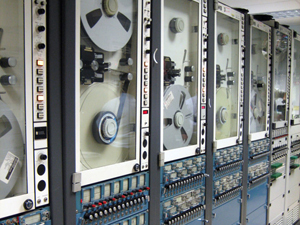Apollo 11 video: Lost and (someday?) found
Those grainy, black and white television images of Neil Armstrong making his one small step onto the lunar surface…Do they fill you with awe? Or maybe, just a little, do they make you want to lean forward, annoyed, and play with the rabbit ears on your 1960s TV set, give it a hard slap on the top…
Those grainy, black and white television images of Neil Armstrong making his one small step onto the lunar surface...Do they fill you with awe? Or maybe, just a little, do they make you want to lean forward, annoyed, and play with the rabbit ears on your 1960s TV set, give it a hard slap on the top, another on the side? Get out the pliers and change the channel?
In fact, the images that came back from the moon were clearer than what the TV audience saw at home. But the moon-to-Earth feed, which was received at stations in Australia and the Mojave Desert, was in an unusual "slow-scan" format due to the low wattage of the transmitter on the lunar lander, which could offer only about a ninth of the bandwidth of a normal TV broadcast. That meant the video required conversion to broadcast TV format as it arrived at Earth. The primitive way this was done? Technicians pointed a broadcast TV camera at a monitor displaying the original video. As you might expect, the quality of the secondary video seen by the world was less than good.
But NASA taped the original video, thank goodness, which could be digitized with modern technology and made available to the public for a much crisper version of the moonwalk.

But, uh, those tapes got locked away somewhere, and in recent years NASA began admitting they couldn't find them.
Until the tapes are found, there's plenty to see on a web site devoted to the important role played during the Apollo missions by the Honeysuckle Creek tracking station outside Canberra, Australia. Check out this neat clip of the Apollo 11 astronauts tossing their portable life support backpacks down the ladder at the end of their moonwalk. According to the web site, this may be the only video of that moment.
This Thursday (July 16, the anniversary of the Apollo 11 launch) Richard Nafzger, a senior engineer at NASA's Goddard Spaceflight Center in Maryland, who has spearheaded the search for the Apollo 11 tapes, will hold a media briefing in Washington, D.C., to release "greatly improved video imagery" from the moonwalk. His team is not calling it the "lost" footage, which is apparently preserved on one-inch tape. The material will feature 15 key moments from the Apollo 11 moonwalk, as seen in the best available broadcast-format versions, "some of which have been locked away for 40 years," according to the announcement. This footage will kick off a comprehensive Apollo 11 moonwallk restoration project to be completed this fall.
In fact, the images that came back from the moon were clearer than what the TV audience saw at home. But the moon-to-Earth feed, which was received at stations in Australia and the Mojave Desert, was in an unusual "slow-scan" format due to the low wattage of the transmitter on the lunar lander, which could offer only about a ninth of the bandwidth of a normal TV broadcast. That meant the video required conversion to broadcast TV format as it arrived at Earth. The primitive way this was done? Technicians pointed a broadcast TV camera at a monitor displaying the original video. As you might expect, the quality of the secondary video seen by the world was less than good.
But NASA taped the original video, thank goodness, which could be digitized with modern technology and made available to the public for a much crisper version of the moonwalk.

But, uh, those tapes got locked away somewhere, and in recent years NASA began admitting they couldn't find them.
Until the tapes are found, there's plenty to see on a web site devoted to the important role played during the Apollo missions by the Honeysuckle Creek tracking station outside Canberra, Australia. Check out this neat clip of the Apollo 11 astronauts tossing their portable life support backpacks down the ladder at the end of their moonwalk. According to the web site, this may be the only video of that moment.
This Thursday (July 16, the anniversary of the Apollo 11 launch) Richard Nafzger, a senior engineer at NASA's Goddard Spaceflight Center in Maryland, who has spearheaded the search for the Apollo 11 tapes, will hold a media briefing in Washington, D.C., to release "greatly improved video imagery" from the moonwalk. His team is not calling it the "lost" footage, which is apparently preserved on one-inch tape. The material will feature 15 key moments from the Apollo 11 moonwalk, as seen in the best available broadcast-format versions, "some of which have been locked away for 40 years," according to the announcement. This footage will kick off a comprehensive Apollo 11 moonwallk restoration project to be completed this fall.